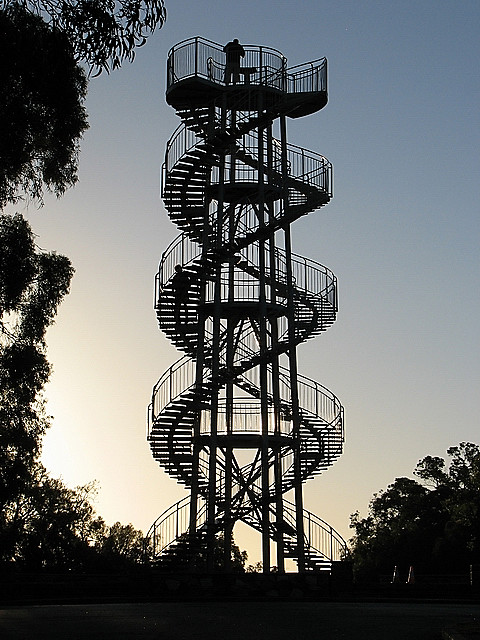Archive for December, 2014
Innovation Through Preparation
 Innovation is about new; innovation is about different; innovation is about “never been done before”; and innovation is about preparation.
Innovation is about new; innovation is about different; innovation is about “never been done before”; and innovation is about preparation.
Though preparation seems to contradict the free-thinking nature of innovation, it doesn’t. In fact, where brainstorming diverts attention, the right innovation preparation focuses it; where brainstorming seeks more ideas, preparation seeks fewer and more creative ones; where brainstorming does not constrain, effective innovation preparation does exactly that.
Ideas are the sexy part of innovation; commercialization is the profitable part; and preparation is the most important part. Before developing creative, novel ideas, there must be a customer of those ideas, someone that, once created, will run with them. The tell-tale sign of the true customer is they have a problem if the innovation (commercialization) doesn’t happen. Usually, their problem is they won’t make their growth goals or won’t get their bonus without the innovation work. From a preparation standpoint, the first step is to define the customer of the yet-to-be created disruptive concepts.
The most effective way I know to create novel concepts is the IBE (Innovation Burst Event), where a small team gets together for a day to solve some focused design challenges and create novel design concepts. But before that can happen, the innovation preparation work must happen. This work is done in the Focus phase. The questions and discussion below defines the preparation work for a successful IBE.
1. Why is it so important to do this innovation work?
What defines the need for the innovation work? The answer tells the IBE team why they’re in the room and why their work is important. Usually, the “why” is a growth goal at the business unit level or projects in the strategic plan that are missing the necessary sizzle. If you can’t come up with a slide or two with growth goals or new projects, the need for innovation is only emotional. If you have the slides, these will be used to kick off the IBE.
2. Who is the customer of the novel concepts?
Who will choose which concepts will be converted into working prototypes? Who will convert the prototypes into new products? Who will launch the new products? Who has the authority to allocate the necessary resources? These questions define the customers of the new concepts. Once defined, the customers become part of the IBE team. The customers kick off the IBE and explain why the innovation work is important and what they’ll do with the concepts once created. The customers must attend the IBE report-out and decide which concepts they’ll convert to working prototypes and patents.
Now, so the IBE will generate the right concepts, the more detailed preparation work can begin. This work is led by marketing. Here are the questions to scope and guide the IBE.
3. How will the innovative new product be used?
How will the innovative product be used in new way? This question is best answered with a hand sketch of the customer using the new product in a new way, but a short written description (30 words, or so) will do in a pinch. The answer gives the IBE team a good understanding, from a customer perspective, what new things the product must do.
What are the new elements of the design that enable the new functionality or performance? The answer focuses the IBE on the new design elements needed to make real the new product function in the new way.
What are the valuable customer outcomes (VCOs) enabled by the innovative new product? The answer grounds the IBE team in the fundamental reason why the customer will buy the new product. Again, this is answered from the customer perspective.
4. How will the new innovative new product be marketed and sold?
What is the tag line for the new product? The answer defines, at the highest level, what the new product is all about. This shapes the mindset of the IBE team and points them in the right direction.
What is the major benefit of the new product? The answer to this question defines what your marketing says in their marketing/sales literature. When the IBE team knows this, you can be sure the new concepts support the marketing language.
5. By whom will the innovative new product be used?
In which geography does the end user live? There’s a big difference between developed markets and developing markets. The answer to the question sets the context for the new concepts, specifically around infrastructure constraints.
What is their ability to pay? Pocketbooks are different across the globe, and the customer’s ability to pay guides the IBE team toward concepts that fit the right pocket book.
What is the literacy level of the end customer? If the customer can read, the IBE team creates concepts that take advantage of that ability. If the customer cannot read, the IBE team creates concepts that are far different.
6. How will the innovative new product change the competitive landscape?
Who will be angry when the new product hits the market? The answer defines the competition. It gives broad context for the IBE team and builds emotional energy around displacing adversaries.
Why will they be angry? With the answer to this one, the IBE team has good perspective on the flavor of pain and displeasure created by the concepts. Again, it shapes the perspective of the IBE team. And, it educates the marketing/sales work needed to address competitors’ countermeasures.
Who will benefit when the new product hits the market? This defines new partners and supporters that can be part of the new solutions or participants in a new business model or sales process.
What will customer throw away, reuse, or recycle? This question defines the level of disruption. If the new products cause your existing customers to throw away the products of your existing customers, it’s a pure market share play. The level of disruption is low and the level of disruption of the concepts should also be low. On the other end of the spectrum, if the new products are sold to new customers who won’t throw anything away, you creating a whole new market, which is the ultimate disruption, and the concepts must be highly disruptive. Either way, the IBE team’s perspective is aligned with the level appropriate level of disruption, and so are the new concepts.
Answering all these questions before the creative works seems like a lot of front-loaded preparation work, and it is. But, it’s also the most important thing you can do to make sure the concept work, technology work, patent work, and commercialization work gives your customers what they need and delivers on your company’s growth objectives.
Image credit — ccdoh1.
Innovation’s Double Helix
 A technology without a market is as valuable as a market without a technology – they’re both worthless. At one end of the spectrum you have something interesting running in the lab and at the other you have an interesting insight around a new market. But one won’t do, and from either end of the rainbow your quest is to find the pot of gold at the other end.
A technology without a market is as valuable as a market without a technology – they’re both worthless. At one end of the spectrum you have something interesting running in the lab and at the other you have an interesting insight around a new market. But one won’t do, and from either end of the rainbow your quest is to find the pot of gold at the other end.
Scenario A – As a marketing leader you went out into the market, heard the unhearable, saw the unseeable and the gears of your mind gnashed and clunked until it brought into being a surprising insight. Now it’s time to come back to the technical community in search of a technology. For this clarity is key, but for technologists the voice of the customer is a foreign language, and worse, you’ve invented a new dialect.
Step 1. Dig up marketing literate for an existing product that’s the closest to satisfying your surprising market insight.
Step 2. In front of the technologists mark up the existing marketing literature so it satisfies the surprising insight. (Think – same as the old product, but different.) Starting with something they know and building from there helps the technologists see the newness from the grounded context of existing products and technologies.
Step 3. Then, with the technologists, draw a hand sketch of the customer using the new product in a new way, then underneath the sketch write a single sentence that describes the valuable customer outcome (from the customer’s perspective).
Step 4. Together with the technologists define the new design elements of the prouct to make the product perform like the sketch and satisfy the valuable customer outcome.
Step 5. With the technologists go out to the lab and make a prototype of the new design element, bolt it on to an existing product platform and use the product in the manner described in your sketch. If it doesn’t work as it should, modify the prototype until it does.
Step 6. Take the prototype to the market and ask them if it delivers on the valuable customer outcome. If it doesn’t, modify the prototype until it does. And when it does, launch it.
Scenario B – As a technologist you went out into the lab, thought the unthinkable, pondered the impossible and the gears of your mind gnashed and clunked until it brought into being a surprising technology. Now it’s time to come back to the marketing community in search of a market. For this clarity is key, but for marketing the voice of the technology is a foreign language, and worse, like your counterpart in Scenario A, you’ve invented a new dialect.
Step 1. Dig up the product spec for an existing product that’s closest to your new technology.
Step 2. In front of the marketers mark up the product spec so it describes the functionality of the new technology. (Think – same as the old product, but different.) Starting with something they know and building from there helps the marketers see the newness from the grounded context of existing products and technologies.
Step 3. Again in front of the marketers, define the new elements of the technology that make the product perform like it does.
Step 4. With the marketers, draw a hand sketch of the customer using the new product in a new way, then underneath the sketch write a single sentence that describes the valuable customer outcome (from the customer’s perspective).
Step 5. Together with the marketers and the prototype go out to the field and let customers use it as THEY see fit. If they use it in the manner described in your sketch, you’ve identified a potential customer segment. If they don’t, modify the sketch and valuable outcome sentence until it matches their use, or seek out other customers who use it like the sketch.
Step 6. Decide on the most interesting product use and customer outcome, and take the prototype to the target customers. Ask them if it delivers on the valuable customer outcome. If it doesn’t, investigate different customer segments until it does. And when it does, launch it.
Scenarios A and B are contrived. In scenario A, product use and valuable customer outcomes are static and the technology changes to fit them. In Scenario B, it’s reversed – static technology and dynamic product use and customer outcomes. While the scenarios are helpful to see the work from two perspectives and define the end points, that’s not how it happens.
Innovation is always a clustered-jumble of the two scenarios. In fact it’s more like a double helix where the customer strand winds around the technology and the technology strand winds around the customer. One strand takes the lead and mutates the other, which, in turn, spirals learning in unforseen directions.
There’s no getting around it – market and technology co-evolve. There’s no best practice, there’s no best orgainizational structure, and breaking things down the smallest elements won’t get you there.
Instead of spending time and money sequencing the innovation genome, take your cue from nature – try stuff and do more of what worked and less of what didn’t.
And remember the cardinal rule – the organization with the best genes wins.
Image credit – kool_skatkat
To improve innovation, improve clarity.
 If I was CEO of a company that wanted to do innovation, the one thing I’d strive for is clarity.
If I was CEO of a company that wanted to do innovation, the one thing I’d strive for is clarity.
For clarity on the innovative new product, here’s what the CEO needs.
Valuable Customer Outcomes – how the new product will be used. This is done with a one page, hand sketched document that shows the user using the new product in the new way. The tool of choice is a fat black permanent marker on an 81/2 x 11 sheet of paper in landscape orientation. The fat marker prohibits all but essential details and promotes clarity. The new features/functions/finish are sketched with a fat red marker. If it’s red, it’s new; and if you can’t sketch it, you don’t have it. That’s clarity.
The new value proposition – how the product will be sold. The marketing leader creates a one page sales sheet. If it can’t be sold with one page, there’s nothing worth selling. And if it can’t be drawn, there’s nothing there.
Customer classification – who will buy and use the new product. Using a two column table on a single page, these are their attributes to define: Where the customer calls home; their ability to pay; minimum performance threshold; infrastructure gaps; literacy/capability; sustainability concerns; regulatory concerns; culture/tastes.
Market classification – how will it fit in the market. Using a four column table on a single page, define: At Whose Expense (AWE) your success will come; why they’ll be angry; what the customer will throw way, recycle or replace; market classification – market share, grow the market, disrupt a market, create a new market.
For clarity on the creative work, here’s what the CEO needs: For each novel concept generated by the Innovation Burst Event (IBE), a single PowerPoint slide with a picture of its thinking prototype and a word description (limited to 12 words).
For clarity on the problems to be solved the CEO needs a one page, image-based definition of the problem, where the problem is shown to occur between only two elements, where the problem’s spacial location is defined, along with when the problem occurs.
For clarity on the viability of the new technology, the CEO needs to see performance data for the functional prototypes, with each performance parameter expressed as a bar graph on a single page along with a hyperlink to the robustness surrogate (test rig), test protocol, and images of the tested hardware.
For clarity on commercialization, the CEO should see the project in three phases – a front, a middle, and end. The front is defined by a one page project timeline, one page sales sheet, and one page sales goals. The middle is defined by performance data (bar graphs) for the alpha units which are hyperlinked to test protocols and tested hardware. For the end it’s the same as the middle, except for beta units, and includes process capability data and capacity readiness.
It’s not easy to put things on one page, but when it’s done well clarity skyrockets. And with improved clarity the right concepts are created, the right problems are solved, the right data is generated, and the right new product is launched.
And when clarity extends all the way to the CEO, resources are aligned, organizational confusion dissipates, and all elements of innovation work happen more smoothly.
Image credit – Kristina Alexanderson
The Prerequisites for Greatness
 There are three prerequisites for greatness.
There are three prerequisites for greatness.
- You have to believe greatness is possible.
- You have to believe greatness is worth it.
- You have to believe you’re worthy of the journey.
If you can’t see old things in new ways, see new things in new ways, or see what’s missing, you won’t believe greatness is possible. To believe greatness is possible, you have to change your perspective.
Greatness is an uphill battle on all fronts, and to push through the pain requires weapons grade belief that it’s worth it. But the power isn’t in the payoff. The power is the personal meaning you attach to the work. Your slog toward greatness is powered from the inside out.
Here’s the tough one – you’ve got to believe you’re worthy of the journey. At every turn the status quo will kick you in the shins, and you must strap on your self-worth like shin guards. And when it’s time to conger greatness from gravel, you must believe, somehow, your life force will rise to the occasion. But, to be clear, you don’t have to believe you’ll be successful; you only have to believe you’re worth the bet.
From the outside, greatness is all about the work. But from the inside, greatness is all about you.
Image credit – Dietmar Temps
Mind-Body Motivation for Innovation
 Mind and body are connected, literally. It’s true – our necks bridge the gap. Don’t believe me? Locate one end of your neck and you’ll find your head or body; locate the other and you’ll find the other. And not only are they connected, they interact. Shared blood flows between the two and that means shared blood chemistry and shared oxygen. And not only is the plumbing shared, so is the electrical. The neck is the conduit for the nerves which pass information between the two and each communicate is done in a closed loop way. Because it’s so obvious, it sounds silly to describe the connectedness in this way, yet we still think of them as separate.
Mind and body are connected, literally. It’s true – our necks bridge the gap. Don’t believe me? Locate one end of your neck and you’ll find your head or body; locate the other and you’ll find the other. And not only are they connected, they interact. Shared blood flows between the two and that means shared blood chemistry and shared oxygen. And not only is the plumbing shared, so is the electrical. The neck is the conduit for the nerves which pass information between the two and each communicate is done in a closed loop way. Because it’s so obvious, it sounds silly to describe the connectedness in this way, yet we still think of them as separate.
When the mind-body is combined into a single element our perspectives change. For one, we realize the significance of the environment because wherever the body is the mind is. If your body walks your mind to a hot place, your body is hot and so is your mind. No big deal? Go to the beach in mid- summer, stand in the 105 degree heat for 1 hour, then do some heavy critical thinking. Whether the environment is emotionally hot or temperature hot, it won’t go well. Sit your body in a noisy, chaotic environment for two hours then try to come up with the new technology to keep your company solvent. Keep your body awake for 24 hours and try to solve a fundamental problem to reinvent your business model. I don’t think so.
Innovation is like a marathon, and if you treat your body like a marathon runner you’ll be in great shape to innovate. Get regular physical activity; eat well; get enough sleep; don’t go out and party every night; drink your fluids; don’t get over heated. If you don’t think any of this matters, do the opposite for a week or two and see how it goes with your innovation. And as with innovation climate, geography and environment matter. Train at altitude and sleep in a hypobaric chamber and your mind-body responds differently. Run up hill and you get faster on the hills and likely slower on the flats. Run downhill and your legs hurt. Run in sub-zero temperatures and your lungs burn.
Just as the mind goes with the body, the body follows mind. If you are anxious about your work, you feel a cold pressure in your chest – a clear example where your mental state influences your body. If you are depressed, your body can ache – another example where your mind changes your body. But it’s more than unpleasant body sensations. Your body does far more than move your head place-to-place. Your body is the antenna for the unsaid, and the unsaid is huge part of innovation. Imagine a presentation to your CEO where you describe your one year innovation project that came up empty. When you stop talking and there’s a minute of silent unsaid-ness, your body picks up the signals, not your mind. (You feel the tightness in your chest before you know why.) But if your mind has been monkeying with your body, your crumpled antenna may receive incorrect signals or may transmit them to your brain improperly, and when the CEO asks the hard question, your mind-body is spongy.
And what fuels the mind-body? Why does it get out of bed? Why does it want to do innovation? Dan Pink has it right – when it comes to tasks with high cognitive load, the mind-body is powered by autonomy, the pursuit of mastery, and purpose. For innovation, the mind-body is powered intrinsically, not extrinsically. If your engineers aren’t innovating, it’s because their mind-bodies know there’s no autonomy in the ether. If they’re not taking on the impossible, it’s because they aren’t given time to master its subject matter or the work they’re given is remedial. If they’re doing what they always did, it’s because their antennas aren’t resonating with the purpose behind the innovation work.
When your innovation work isn’t what you’d like it’s not a people problem, it’s an intrinsic motivation problem. Innovators’ mind-bodies desperately want to pole vault out of bed and innovate like nobody’s business, but they feel they have too little control over what they do and how they do it; they want to put all their life force into innovation, but they know (based on where their mind-bodies are) they’re not given the tools, time, and training to master their craft; and the rationale you’ve given them – the “WHY” in why they should innovate – is not meaningful to their mind-bodies.
Innovation is a full mind-body sport, and the importance of the body should be elevated. And if there’s one thing to focus on it’s the innovation environment in which the mind-body sits.
Innovators were born to innovate – our mind-bodies don’t have a choice. And if innovation is not happening it’s because extrinsic motivation strategies (carrots and sticks) are blocking the natural power of our intrinsic motivation. It’s time to figure that one out.
Image credit – Eli Duke
 Mike Shipulski
Mike Shipulski